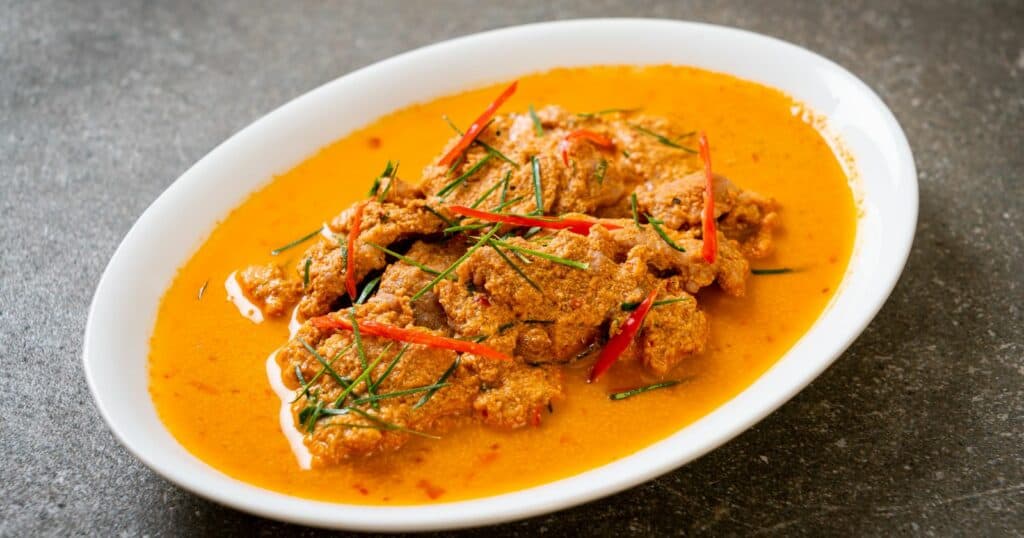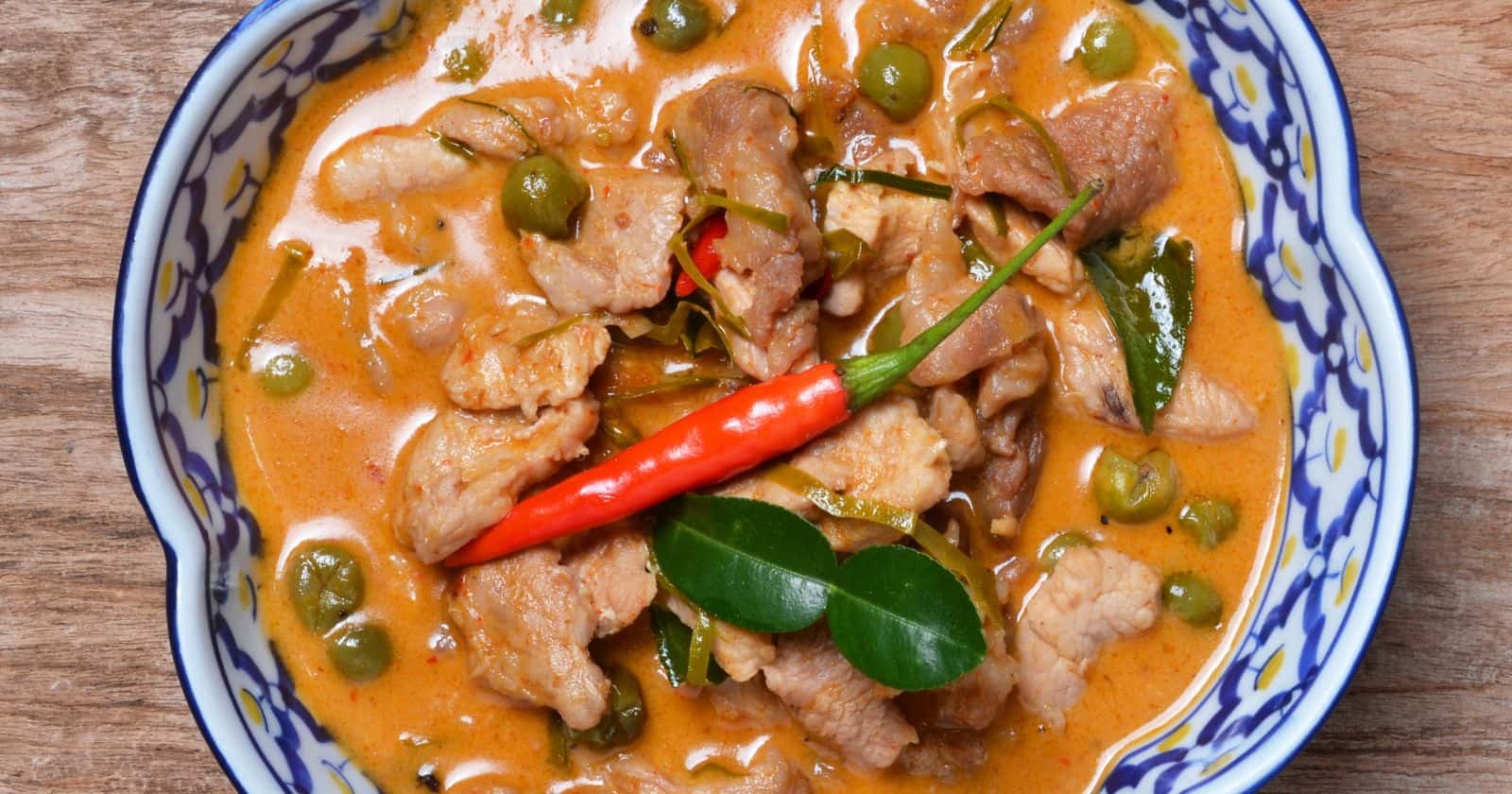Thai food fanatics know that panang curry is a mouthwatering staple. But the real burning question is – is panang curry spicy?
The answer depends on who you ask. Some say panang packs a serious punch, while others call it a milder curry cousin.
Here’s the tasty truth…
Compared to the likes of fiery red curry, panang ranks around a 5 out of 10 on the spiciness scale. This peanut-powered curry simmers chilies into a rich, creamy sauce for a slow building burn.
Panang combines nutty, sweet, sour, and savory flavors alongside that gentle
Curious to learn more about panang’s craveable complexity? Read on for everything you need to know about this aromatic Thai treat. You’ll discover just how hot panang curry gets – plus tips for taming the heat if it gets too fiery for your tastes!
What Exactly is Panang Curry?

Panang refers to a specific type of Thai curry made with a rich, peanut-based sauce. Unlike other Thai curries that use coconut milk as the primary liquid, panang gets its luxuriously creamy texture from coconut cream.
Panang curry paste is made from a blend of dried chilies, garlic, galangal, lemongrass, cumin, coriander seeds, and roasted peanuts. This aromatic mixture is simmered with coconut cream and your choice of meat or vegetables to create the curry. Chicken, beef, shrimp, and tofu are common panang ingredients.
The dish is often garnished with crunchy peanuts, strips of lime leaf, and fresh Thai basil. The complex medley of tastes and textures is what makes panang so crave-worthy!
The Origins of Panang Curry
While many Thai curries can be traced back centuries, panang is a relatively new arrival on the scene. This flavorful curry was developed in the mid-20th century in Thailand.
The dish gets its name from the island of Penang in Malaysia, which influenced the blend of tastes. Early versions used roasted peanuts native to the region to give panang its signature nutty flavor.
Over the years, Thai cooks put their own spin on panang by tweaking the paste ingredients. Their adaptations created the rich, mildly spicy curry we know and love today.
How Spicy is Panang Curry?
Now that you know what it is, let’s address the spicy question.
Panang curry is considered moderately spicy on the Thai cuisine
However, panang still packs a pleasant punch thanks to the blended chilies in the curry paste. The rich, nutty sauce also helps temper the heat.
So compared to other Thai staples, panang ranks around a 5 out of 10 on the spiciness scale. But it ultimately depends on the recipe and your own heat tolerance!
What Impacts the Spice Level?
Several factors affect how hot your panang curry turns out:
- Panang curry paste – The more chilies used in the paste, the spicier the curry. Homemade pastes vary in heat. Store-bought jars are milder.
- Adding extra chilies – Some recipes call for fresh red chilies to amp up the
spice . Leave them out for a tamer curry. - Coconut cream vs. coconut milk – Coconut cream has a higher fat content that mellows out chilies. Coconut milk makes a less creamy, spicier curry.
- Meat vs. vegetables – Heartier meats stand up to spiciness. More delicate tofu and veggies feel the burn more.
- Individual tastes – One person’s fiery dish is another’s mildly spiced.
Spice tolerance is subjective!
In general, panang hits that ideal balance of flavored heat for most palates. But tweak these factors to personalize the punch.
Panang Curry Paste vs. Other Thai Curry Pastes
What sets panang paste apart from other Thai curry pastes? It comes down to a few key ingredients:
- Peanuts – Ground, roasted peanuts add body and nutty sweetness. They’re the panang paste’s distinguishing ingredient.
- Spice blend – Panang combines warming spices like cumin, coriander, and cinnamon rather than a straight chili punch.
- Shrimp paste – Fermented shrimp adds deep umami savoriness not found in red or green curry pastes.
- Palm sugar – A touch of sweet palm sugar balances out the chili heat.
These components come together to create panang’s one-of-a-kind flavor that plays well with the rich coconut cream base.
Describing the Flavor Profile
Beyond the
Nutty, sweet, sour, savory, spicy – panang curry combines it all into one mouthwatering bite. Here’s a flavor breakdown:
Nutty
The big peanut flavor comes from using both peanuts and peanut oil in the curry paste. This nuttiness sets panang apart from other curries.
Sweet
Palm sugar adds pleasant sweetness that counters the chili heat. Coconut cream also lends natural sweetness.
Sour
A splash of lime juice right before serving gives panang a tangy complexity. The fresh lime zest in the paste also contributes.
Savory
Panang gets its rich, savory depth from shrimp paste and fish sauce in the curry blend. This umami backbone balances the sweet and sour.
Spicy
Dried chilies, garlic, and pepper provide a gentle yet persistent heat. Expect a slow, building burn that doesn’t overpower.
Herbal
Pungent herbs like basil, cilantro, and kaffir lime leaves infuse each bite of panang curry with freshness. This bright topnote ties everything together.
When combined in perfect harmony, these flavor layers make panang irresistible over a bowl of jasmine rice.
How Panang Curry Compares to Other Curries Worldwide
Thai panang curry certainly brings a punch of heat. But how does it stack up to other famously fiery curries from around the globe?
- Indian curries like vindaloo and tikka masala can be scorching thanks to lots of cayenne and chili powder. Panang is milder with its blend of dried and fresh chilies.
- Jamaican curries get their heat from scotch bonnet peppers. These small but mighty chilies out-spice panang’s gentler chili blend.
- Japanese curries tend to be on the sweeter, milder side. Panang has a bolder chili flavor thanks to the curry paste.
- Malaysian curries like rendang and kari ayam are close cousins to panang. Their
spice levels vary but are often similarly medium-hot. - Indonesian curries also have a wide range depending on region. Some like Sumatran curries give panang a run for its money
spice -wise!
While Thai panang may not be the absolute spiciest curry worldwide, it can hold its own. Its unique flavor profile keeps fans coming back despite the heat.
The richness of the coconut milk and peanut sauce allows the chilies to build slowly rather than punch you in the face all at once. This makes panang very approachable, even for people sensitive to
How To Make Panang Curry Paste
Want to experience authentic panang flavor? Making your own curry paste is a fun way to customize the heat and taste.
Most cooks use a mortar and pestle to slowly blend the ingredients into a thick, aromatic paste. Here’s an easy homemade panang curry paste recipe:
Ingredients:
- 6 dried red chilies
- 2 shallots, diced
- 4 garlic cloves
- 1 tablespoon lemongrass
- 1 tablespoon galangal
- 1 teaspoon cumin
- 1 teaspoon coriander
- 1/4 cup roasted peanuts
- 1 tablespoon shrimp paste
- 1 tablespoon brown sugar
- 1 teaspoon salt
- 1 tablespoon peanut oil
Instructions
- Soak dried chilies in hot water for 15 minutes until softened. Drain and chop.
- In a mortar and pestle, crush the chilies, garlic, shallots, lemongrass, galangal, cumin, and coriander into a rough paste.
- Add peanuts and pound until incorporated but still chunky.
- Mix in shrimp paste, brown sugar, and salt.
- Slowly drizzle in peanut oil while mashing until blended.
- Transfer to an airtight jar and refrigerate up to one week.
When ready to use, just scoop out the desired amount of homemade curry paste and simmer in coconut cream and meat or veggies. Adjust the chili quantity to make it as mild or spicy as you like!
How To Make Panang Curry
Once you’ve got your paste, making panang curry is a breeze. Try this basic recipe to enjoy the complex sweet, sour, nutty flavors:
Ingredients:
- 2 tablespoons panang curry paste
- 1 pound chicken or beef, chopped
- 1 cup coconut cream
- 1 cup coconut milk
- 1-2 tablespoons fish sauce
- 1 tablespoon palm sugar
- 8 oz. chopped vegetables like peppers, broccoli, carrots, etc
- Juice of 1 lime
- Basil, cilantro, peanuts for garnish
Instructions:
- In a skillet over medium heat, fry curry paste for 2-3 minutes until fragrant.
- Add meat and cook until browned on all sides.
- Pour in coconut cream, coconut milk, fish sauce, and palm sugar. Simmer for 10 minutes.
- Stir in vegetables and cook 5 more minutes until tender.
- Remove pan from heat. Stir in fresh lime juice.
- Garnish with basil, cilantro leaves, and chopped peanuts.
- Serve panang curry over jasmine rice and enjoy!
Pro tip: For a vegan version, use chopped extra firm tofu instead of meat.
The beauty of panang is that it’s versatile. Switch up proteins, play with
Frequently Asked Questions
Still wondering if panang packs enough heat for you? Here are answers to some common questions:
Is panang curry as spicy as red curry?
No, panang curry is milder than red curry. Red curry gets its intense burn from hot Thai chilies. Panang chilies are tempered by creamy coconut.
How does panang compare to green curry heat?
Green curry is hotter, thanks to lots of fresh green chilies in the paste. Rich panang has a slower, mellower
What protein should I use if I don’t want it too spicy?
Hearty beef and chicken hold up well to panang’s gentle heat. Delicate tofu will feel spicier. Seafood like shrimp and scallops also work for a milder curry.
Can I adjust the spices if it’s too hot?
Yes! If the panang curry starts to overpower, stir in an extra splash of coconut cream to mellow out the burn.
Is massaman curry similar in heat to panang?
Massaman curry uses similar warm spices but typically skips the fresh chilies. So it’s even milder than panang curry.
Satisfy Your Panang Cravings
Part of panang curry’s allure lies in its addictive spicy-nutty-creamy flavor combination. Now that you know it packs a medium punch compared to other Thai staples, you can enjoy this complex treat properly armed!
Search around Asian markets to find prepared panang curry pastes to use at home. Or whip up your own from-scratch paste and customize the
However you choose to make it, a warm bowl of fragrant panang curry over fluffy jasmine rice will soon have you craving more. Just be ready for that slow burn – and have some coconut cream handy to tame the heat if needed!





